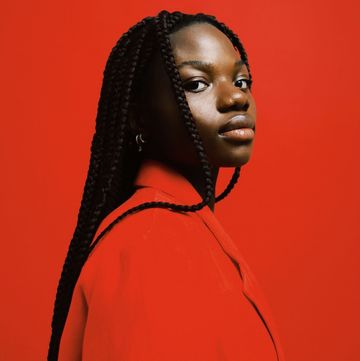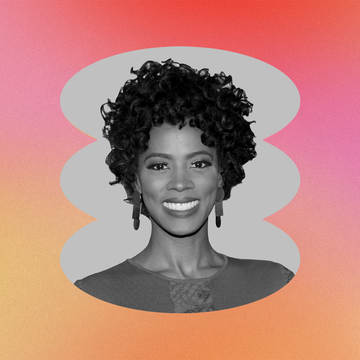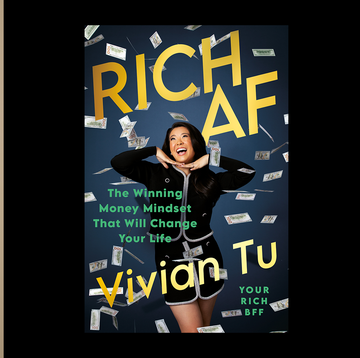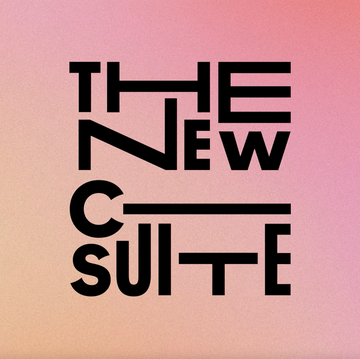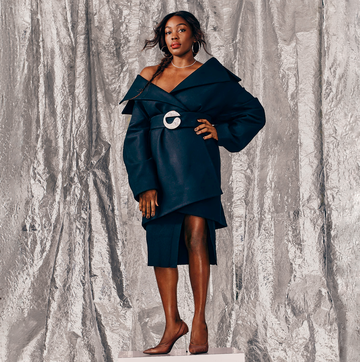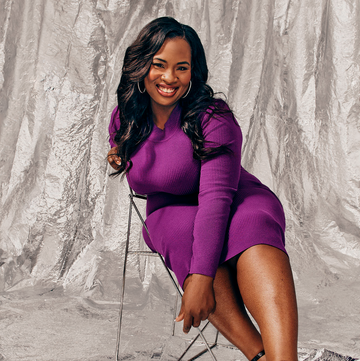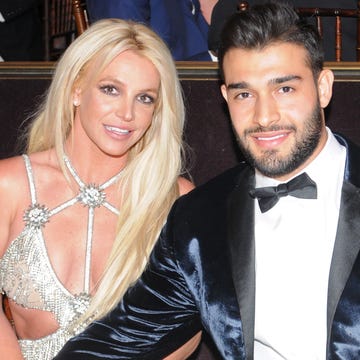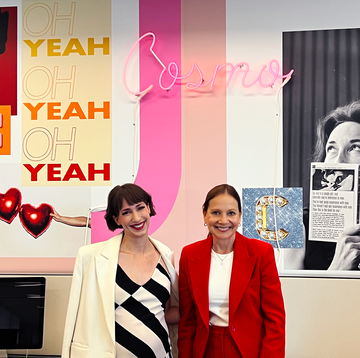You may have seen me on Monday Night Football last fall, cheering and waving pom-poms. The camera only caught me for a few seconds at a time, but grabbing even that sliver of the spotlight took a hell of a lot of ambition on my part—not to mention blood, sweat, and tears.
Growing up, I'd taught myself how to dance in my bedroom, and I eventually shimmied my way into teach- ing a hip-hop class at a gym. One day, a student who was a cheerleader for the local NFL team told me I should audition for the squad. Flattered by the invitation but convinced I had no shot, I showed up at tryouts—along with hundreds of other girls.
Despite my doubts, I aced the first round, which was to freestyle dance to hip-hop. After two weeks of performing in a bikini, being interviewed at length, undergoing a public-speaking evaluation, and taking a football- knowledge exam, a battery of drug tests, and a physical, I made the cut.
Looking the Part
I quickly found out that the hardest part of professional cheerleading isn't learning the eight counts, high kicks, or whatever cheesy dance move we were being taught. It was always looking perfect. Our contracts actually said, "Your appearance must be impeccable at all times."
We were required to have nails manicured with light or clear polish. We could be pulled from cheering at a game if we showed up with curls when management had mandated straight hair (even if pouring rain guaranteed that a girl's naturally wavy hair would coil back up after mere seconds) or if our skin looked too pale, sunburned, or orangey from fake tanning. Though I was once told I was getting too tan, I generally managed to keep my sun damage to the right hue...and I have permanent leopardlike discolored spots on my back to show for it.
We had to ask the coaches for permission to change our physical appearance (say, to get a haircut or highlights), unless, of course, management ordered the makeover. One day, I was told to go to a preordained salon and pay out of my own pocket to have my hair dyed a different color, one that they'd chosen for me. Their reasoning? My natural hue made me look "too ethnic." My half-white, half- Latina jaw nearly hit the floor.
But that was just the beginning of the nonstop scrutiny that came to define my life on the squad. We each received a list of every muscle group (back, inner thighs, outer thighs, quads, biceps, obliques, upper abs, etc.), with detailed comments on which ones we needed to change.
My assignment was to "maintain," except for my lower abs, where I needed to "reduce inches." I was lucky compared with the teammate who was told to tighten the torso, lose the chicken fat on her arms, reduce 2 inches on both thighs, and lose the muffin top.
Weighing In
Three days before the first game, without ever having gotten my body fat or height measured, I was told that "physical fitness standards" required me to weigh no more than 122 pounds. I hadn't clocked in at that weight since puberty (I'm 5 feet 3 and really muscular).
The first time I weighed in at 127 pounds, the choreographer assured me that it was just gas. But when the scale still showed 127 pounds on game day, I was pulled from the performance, even though my family had driven eight hours from my hometown to see me cheer. Adding insult to injury, the next day at practice, the choreographer—with whom I had a contentious relationship, probably because I wasn't a "real" dancer—offered me the cookie from her lunch, knowing very well I couldn't eat it.
Determined to make the required weight by game two, I took a week off from my full-time job, hired two personal trainers, did three hours of cardio and 30 minutes of ab work per day, and ate nothing but canned tuna and almonds. Exactly one week later, I weighed 118....I'd lost 9 pounds (and an entire bra cup size) in seven days! The choreographer patted my butt and said "Good girl!"
I grew to dread those pregame weigh-ins. No one would eat or drink that day for fear of gaining weight. I would get up early and sit in the gym's steam room for hours in hopes of sweating out a few extra ounces. All the cheerleaders would jockey to be first in line to step on the scale, because the sooner you weighed in, the more precious seconds you had to scarf down energy bars before dancing and cheering for four exhausting hours straight.
Over the next several months, I alternated between starving myself and purging, operating solely on caffeine, herbal energy supplements, and a fear of being yelled at in front of the entire team. I got colonics, had body wraps, took diet pills, fasted, and got enemas. Eventually, I had not just the six-pack abs they wanted, but visible ribs and dangerously low body fat to boot.
Soured Team Spirit
It's inevitable: When you put 35 hungry, pretty girls together, reality-show levels of drama ensue. Once tryouts were over, we were still competing with each other—one fewer girl on the field meant more screen time for everyone else. Take the chick who tried to get me benched by telling my coach that I'd gotten into a big party by citing my cheerleader credentials (a no-no). I was able to prove that it wasn't true, but plenty of other girls were tattled into suspensions.
As bitchy as things got, there was also incredible bonding. For example, every time someone had a bad day or a breakup, most of the rest of the group would rally around her. But just because the friendships were real, it doesn't mean they were al- ways healthy—our social lives consisted of hours at the gym, followed by tanning sessions or manicures. We'd share advice on detox diets, diuretics, and colon-cleansing pills.
Best-Behavior Standards
Besides looking good, I was expected to act like an angel. My contract forbade me from drinking, cussing, smoking, chewing gum, or identifying myself as a cheerleader in public. At one point, I was told that if I got another speeding ticket, I'd be fired.
While our code of conduct required us to act like nuns, strangers got away with groping us (I lost count of how many guys did the arm-over-shoulder boob grab to me when posing for pictures). These weren't just random fans either but corporate backer types who paid big bucks for the privilege of hanging out with us.
One of the most heartbreaking moments for me was when my proud dad saw me at a pregame appearance and came to hug me. I had to push him away—we'd been told to reject hugs from friends and family, lest people get the wrong idea.
The biggest rule was that we weren't allowed to fraternize with the football players. I was already friends with some of the guys from college and even had dated one for a while. He and I tried hanging out secretly, but it faded out because we were putting more work into keeping it covert than actually having a relationship.
That's not to say the rule successfully kept romances from happening. One teammate quit the squad to marry a player, and some girls openly admitted that they cheered to "gold dig"— they referred to flirting with players as "operation unemployment."
Burning Out
Everything about me was up for commentary. My coach informed me that while management loved my dimples, my smile wasn't fitting in with the team's image. "You have a great, outgoing personality, but can you take it down a notch?" I even had to turn down public appearances for my media job (as in, the one that actually paid my bills) because the squad worried I was a risk to their reputation.
The constant negative feedback and constraining rules were murdering my self-esteem. I was always pissy, uptight, and hungry. I snapped at people for no reason, and most of my friends abandoned me because, between work and cheering, I was too busy to get together.
During all this, my best friends met with my mom about their concern for me and how I'd become a different person...one they weren't too fond of. They tried to remind me how much more secure and happy I was pre- cheerleading. But I was so wrapped up in the attention I was getting that I didn't give them a second thought.
And at least it was lucrative, right? Ha! We made $6 an hour for games (10 per season) and practice (about 7 to 10 hours a week), plus $12 an hour for appearing at special events. My total earnings as a pro cheerleader in 2006 were $3,000, but after I deducted the expenses (manicures, makeup, trainers, etc.), that dropped to $300. And for what? The glory of moonwalking (no, really) for the drunk guys in the lower tiers? Some girls even wound up in the red after deducting things like plastic surgery as work-related expenses.
The Power of the Uniform
The real motive of cheering isn't money anyway—most girls, myself included, become addicted to the pseudocelebrity status that comes with those pom-poms. I did get my 15 minutes of fame, and the contagious excitement of football season makes you feel like you're a part of something huge.
I was moved by the way little girls looked up to me, but when I started to think about what I was a role model for, I realized I'd sacrificed my entire identity just to get into that uniform. And so, when it came time for a second season, I opted out. I still have close friends on the squad, and we hang out often. As they order lettuce for lunch and complain about the latest crackdown, I just grin and reach for my cheese fries.
This article was originally published as "Tales of an NFL Cheerleader" in the November 2007 issue of Cosmopolitan. Click here to subscribe to the digital edition!

